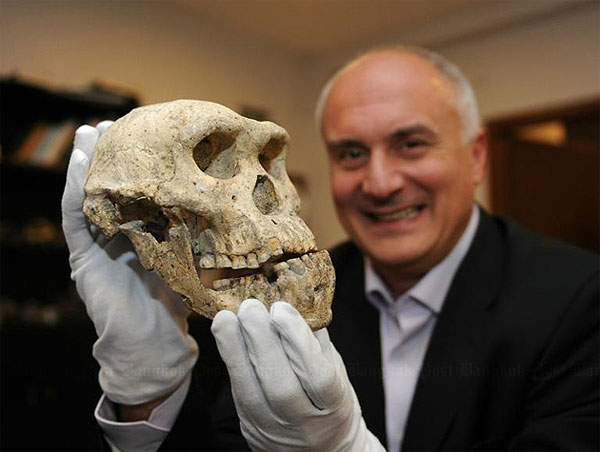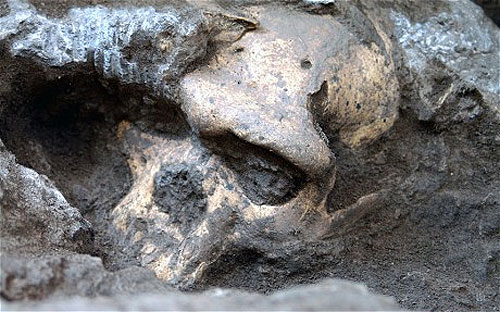
David Lordkipanidze, the director fo the Georgian National Museum, holds the skull from 1.8 million years ago during a press conference in Tbilisis, on October 18, 2013. AFP
By Terry Fredrickson
Skulls found in Georgia suggest that early human-like individuals may have looked very different from each other, but were likely members of the same species.
Click button to listen rightclick to download
Georgia shows off skull thought to rewrite human evolution

The skull before it was extracted from its original resting place. AFP
Tbilisi, AFP — Georgian scientists on Friday presented a 1.8 million-year-old skull discovered in the Caucasus nation that researchers say could force a re-evaluation of current theories of human evolution
The skull – unearthed in the medieval town of Dmanisi some 100 kilometres southwest of the capital Tbilisi – is the first completely preserved skull found from that period
Along with four other skull samples uncovered at the site it appears to show that early man was a single species with a wide range of looks rather than several distinct species
"Today in this skull – and the other Dmanisi samples – we see all the features lumped together in one group that we previously thought identified different groups," David Lordkipanidze, Georgia's national museum director, told AFP after a presentation in Tbilisi on Friday.
The collection – which is housed in the vault of Georgia's national museum – is "the richest collection of hominids in the world from that time", according to Lordkipanidze, the lead researcher on the project.
The stunningly well-preserved find – known as Skull 5 – has an almost-complete set of teeth and seems more elongated than a normal human skull.
The fossil – which is about a third the size of a modern human head – is normally kept in a special padded box in the vault
Wearing white gloves to avoid contaminating the sample a beaming Lordkipanidze held up both the jaw and main section of the skull as photographers took pictures.
A replica of the skull was unveiled for display to visitors in the museum
The conclusions – published in the US journal Science on Thursday – are the result of some eight years of research carried out by Georgian and international scientists since the discovery of the skull in 2005.
The skull was found lying a few metres from where its jawbone had been discovered earlier in 2000.
The skulls vary so much in appearance that under other circumstances, they might have been considered different species said co-author Christoph Zollikofer of the University of Zurich.
"Yet we know that these individuals came from the same location and the same geological time, so they could, in principle, represent a single population of a single species " he said.
"The five Dmanisi individuals are conspicuously different from each other, but not more different than any five modern human individuals, or five chimpanzee individuals, from a given population," said Zollikofer.
They also suggest that early members of the modern man's genus Homo, first found in Africa, soon expanded into Asia despite their small brain size.
But not all experts agree.
"I think that the conclusions that they draw are misguided," said Bernard Wood, director of the hominid paleobiology doctoral program at George Washington University.
"What they have is a creature that we have not seen evidence of before," he said, noting its small head but human-sized body.
"It could be something new and I don't understand why they are reluctant to think it might be."
The site of the discovery – thought to have been close to an important water source – also contained rudimentary stone tools hinting at early butchery techniques and the bones of large, sabre-toothed cats.
Vocabulary
appear: to seem - ดูเหมือนจะ, ดูเหมือนว่า
collection: a group of objects, often of the same sort, that have been collected (gathered together over period of time) - การสะสม การเก็บรวบรวม
current: of the present time - ปัจจุบัน
discover: to find somebody/something, or learning about something that was not known about before - ค้นพบ
distinctive: easy to recognize because it is different from other things - พิเศษ, มีลักษณะเฉพาะ
elongated: long and thin, often in a way that is not normal - ซึ่งยืดออกไป
evolution: the gradual development of plants, animals, etc. over many years as they adapt to changes in their environment; the gradual development of something - วิวัฒนาการ
feature: something important, interesting or typical of a place or thing - จุดเด่น, คุณสมบัติ
fossil: the remains of an animal or a plant which have become hard and turned into rock - ซากพืชหรือสัตว์ที่เป็นหิน, ซากฟอสซิล
hominid: a human, or a creature that lived in the past which humans developed from - สมาชิกตระกูลคน
identify: to specify - ระบุ
lump: to put or consider different things together in the same group - รวมกัน
medieval: connected with the Middle Ages (about AD 1000 to AD 1450) - เกี่ยวกับสมัยกลาง
museum: a building where objects of historical, scientific or artistic interest are kept - พิพิธภัณฑ์
normal: typical, usual or ordinary; what you would expect - ปกติ, ภาวะปกติ
padded: covered with a thick piece of soft material - คลุมด้วยนวม
period: a length of time in the life of a particular person or in the history of a particular country - ยุค, ช่วง, กาล
preserved: kept in good condition, not damaged or destroyed - คงอยู่, สงวนไว้
press conference: an official meeting where someone makes a formal statement about a particular issue or event to journalists and answers their questions about it - การแถลงข่าว
range: a number of different things that are of the same general type - ขอบข่าย, ประเภท
re-evaluation: to think about something again, especially in order to form a new opinion about it - การประเมินใหม่
researcher: a person who carriers out a careful study of a subject, especially in order to discover new facts or information about it - นักวิจัย
sample: a small amount of a substance that is used for scientific or medical tests - ตัวอย่างทดลอง
site: a place where something is located - สถานที่
skull : the bones of the head - กระโหลกศีรษะ
species: a set of animals or plants in which the members have similar characteristics to each other and can breed with each other - พันธ์,จำพวก
stunning: very impressive or beautiful - สวยตระการตา น่าตะลึง
theory: one or more ideas that explain how or why something happens - สมมติฐาน
third: one third; 1/3 - เศษหนึ่งส่วนสาม, 1/3
unearth: to find something that is buried in the ground - ขุดขึ้นมา
vault: a room, especially in a bank, with thick walls and a strong door, which is used to store money or valuable things in safe conditions - ห้องเก็บเงินในธนาคาร



